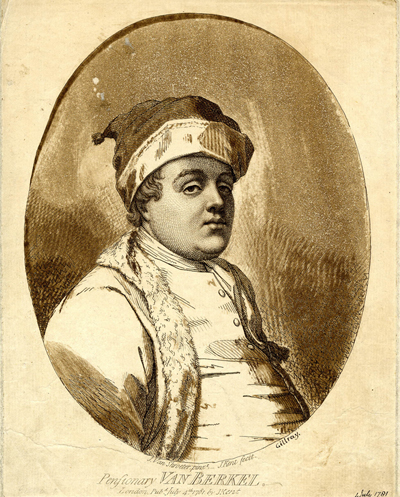Pensionary Van Berkel
This is one of two portraits by Gillray of well-known opponents of British interests: the Marquis La Fayette, the French General who provided so much military support for the American revolution, and Pensionary Van Berkel, the instigator of a secret treaty with the Americans and major critic of the policies of William V, Prince of Orange. Both show Gillray experimenting with rollers, stippling, and aquatint—techniques more often used in "serious" portraiture than caricature. Both are listed as being published on the same day, July 4th, 1781, 5 years to the day that America declared her independence. And both list the publisher as "J. Kent," a pseudonym Gillray used frequently in the 1780's, but usually as the engraver ("J. Kent fecit") rather than publisher.

© Trustees of the British Museum
If we assume that the British Museum is correct in attributing the production of a slightly earlier print of Hyder Ally (June 13, 1781) to Gillray, the La Fayette and Van Berkel prints seem to have been part of a concerted effort by Gillray in 1780-1781 to earn a living from sources other than caricature/satire. This would have included portraits of people in the news (like this one), illustrations of literary works like Tom Jones in August and September 1780, and the production of sentimental furniture prints (five in November 1781).
Gillray's involvement in the portrait of Hyder Ali for the publisher Robert Wilkinson seems to have been confined to the tracing and etching of an earlier French print. But it may have suggested the portraits of La Fayette and Van Berkel as potential experiments and moneymakers. And the fact that the publisher is NOT Wilkinson may indicate that Gillray was experimenting with more than just technique and subject matter. He may have felt that he could increase his share of the profits from his efforts if he was his own publisher.
Pensionary Van Berkel was the head of a party in Holland that resented the eroding power and influence of Holland as a result of English interests. So when the American colonies revolted against England, Van Berkel supported their cause seeing an opportunity to weaken the power of Britain and to profit from the covert sale of arms and other materials to America. In September, 1780, the Dutch denials of not so secret support were exploded by the seizure of a packet ship carrying an American diplomat to the Hague. On board were numerous papers and correspondence including the plan of a treaty of alliance between Holland and America dated as early as 1778 signed by Van Berkel himself. Britain called for the punishment of Van Berkel and a disavowal of his policies. But it soon became clear that their outrage was falling on deaf ears. The economic benefits of allying themselves with the French and Americans were greater in the eyes of Van Berkel and his compatriots than any loyalty to British treaties.
Van Berkel was obviously a persona non grata in Britain, so it is impossible for Gillray's portrait to have been taken from the life. So Gillray must have based his image upon an existing print. But I've been unable to find any source that even remotely resembles the paunchy and sleepy-eyed image of Ven Berkel that Gillray presents.
Sources and Reading
- Commentary from the British Museum on Pensionary Van Berkel
- "Engelbert François van Berckel," Wikipedia
- Philip Henry Stanhope Mahon, History of England: From the Peace of Utrecht to the Peace of ..., Volume 7, pp 80–81.
Comments & Corrections
NOTE: Comments and/or corrections are always appreciated. To make that easier, I have included a form below that you can use. I promise never to share any of the info provided without your express permission.